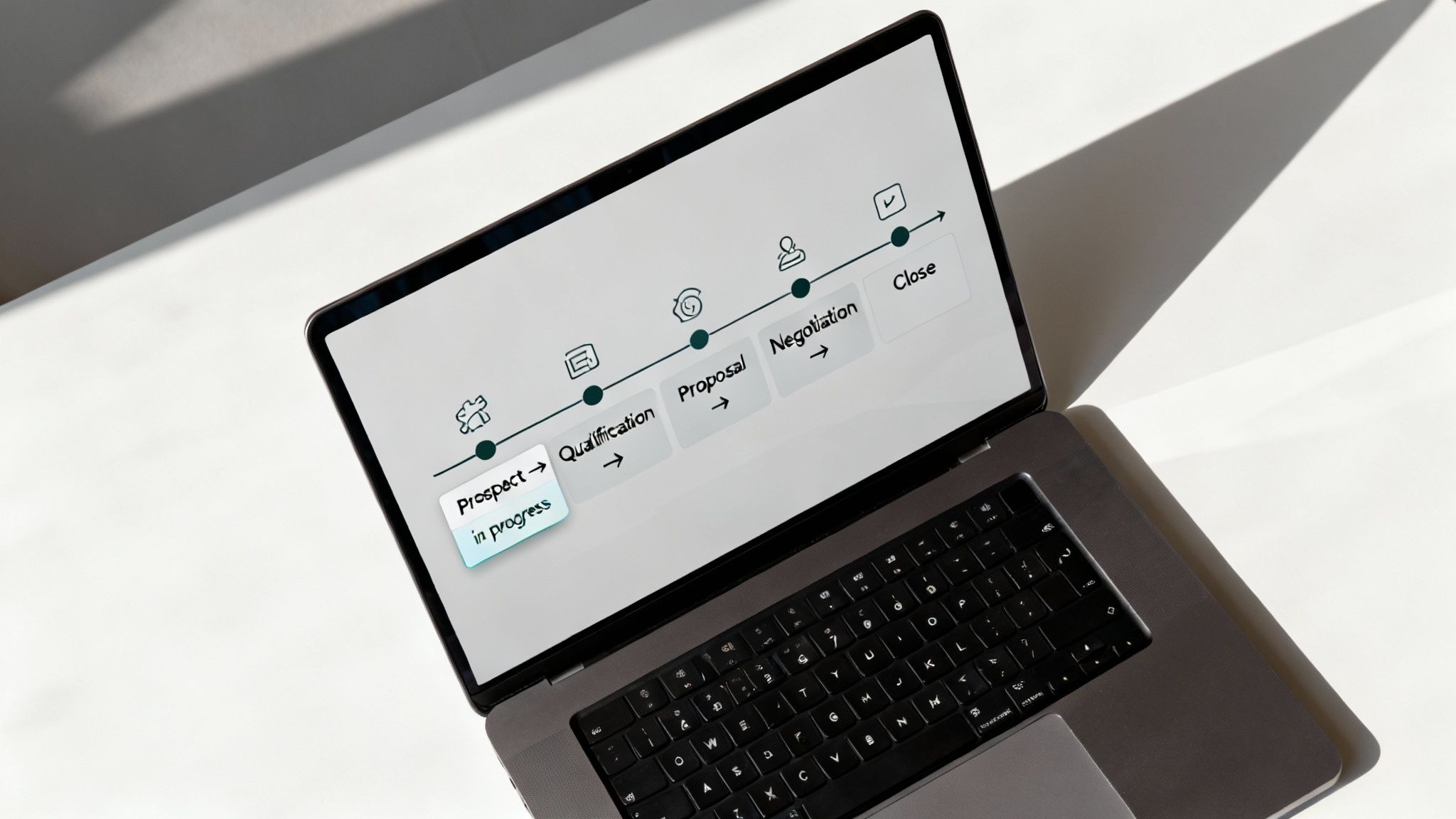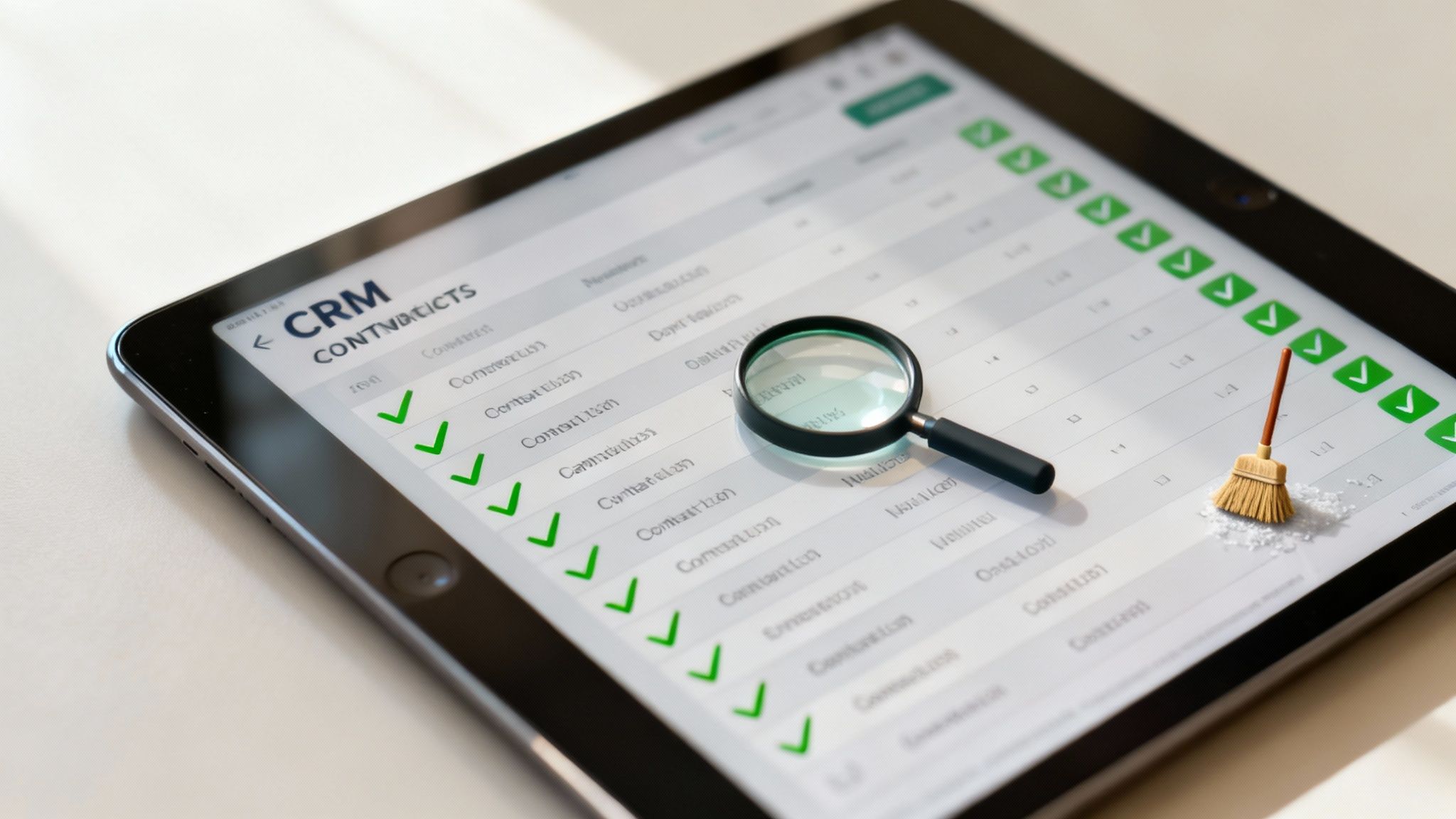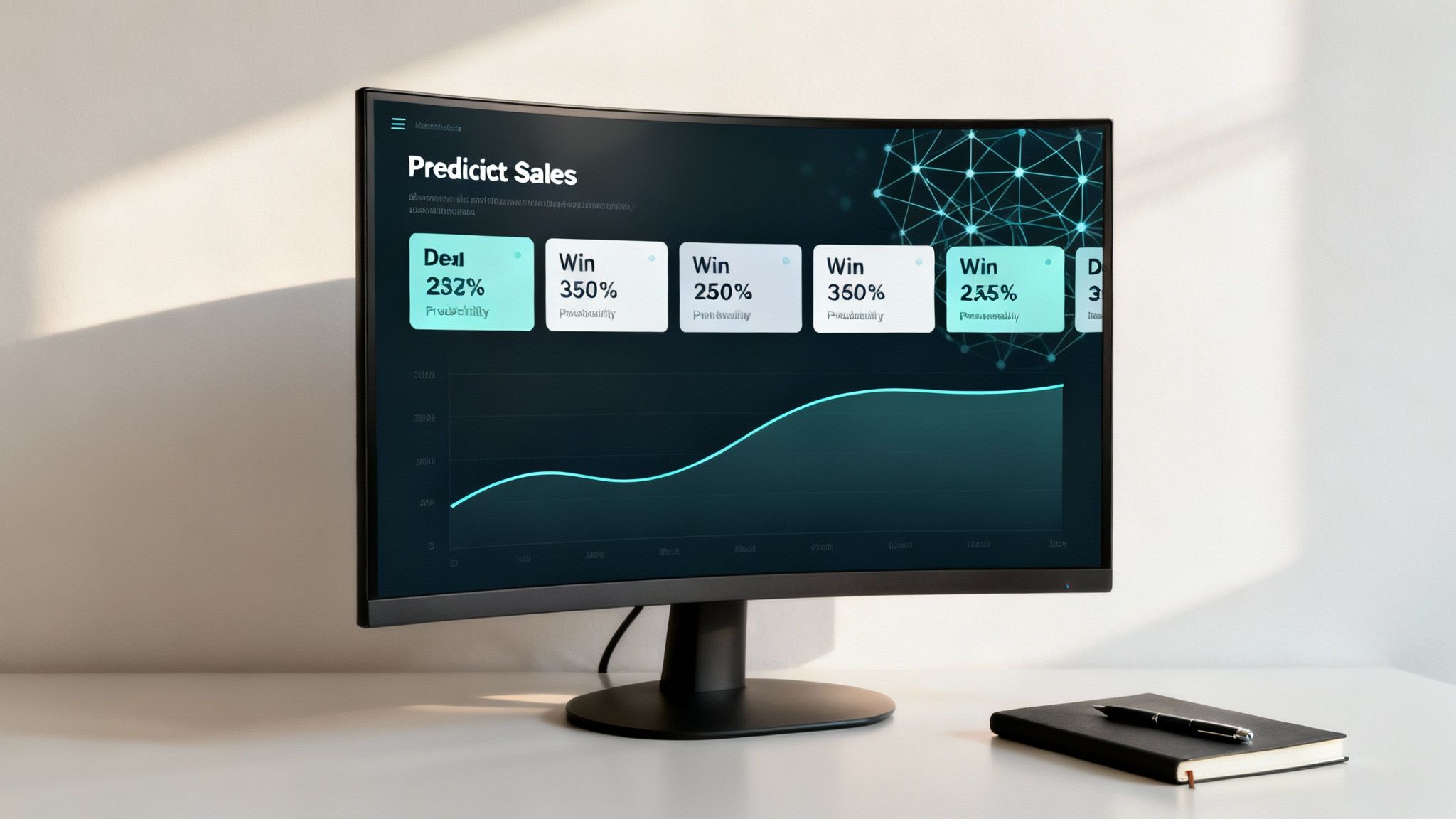A well-managed sales pipeline is the engine of predictable revenue. Yet, many organizations grapple with stalled deals, inaccurate forecasts, and a lack of visibility into what’s actually working. Moving beyond basic deal tracking to strategic, proactive management is no longer optional; it's essential for sustainable growth. The difference between a high-performing sales team and an average one often lies in their process discipline and the systems they use to enforce it.
This guide outlines 10 actionable sales pipeline management best practices that will transform your process from a simple list of opportunities into a powerful, data-driven revenue machine. We will move past generic advice to provide specific, tactical steps to optimize every stage. You'll learn how to implement robust qualification frameworks, maintain pristine CRM data, and leverage automation to keep deals moving forward.
These strategies are designed to provide clarity, improve efficiency, and empower your team to close more deals, faster. Whether you're a sales leader refining your entire process or a representative looking to optimize your personal workflow, these expert-backed insights will provide a clear blueprint for success.
1. Define Clear Sales Stages and Criteria
The foundation of effective sales pipeline management is a clearly defined, universally understood sales process. This involves mapping out distinct stages a deal moves through, from initial contact to a closed win. Ambiguity in your pipeline stages leads to inconsistent data, inaccurate forecasting, and sales reps operating with different playbooks.

When each stage has specific, measurable, and objective exit criteria, everyone on the team knows exactly what must happen for a deal to progress. This eliminates guesswork and "happy ears" reporting, providing a realistic view of your sales health. For example, a deal can’t move from "Qualified Lead" to "Proposal" until a specific discovery call has been completed and documented in the CRM.
How to Implement This Practice:
To create a robust framework, start by involving your entire sales team. Their frontline experience is invaluable for defining stages that reflect the real-world customer journey.
- Define Exit Criteria: For each stage, document the non-negotiable actions that must be completed. For a "Proposal" stage, criteria might include "Received verbal confirmation of budget" and "Identified all key decision-makers."
- Use Historical Data: Analyze past winning deals to set realistic timeframes for how long a deal should stay in each stage. This helps identify stalled opportunities that need attention.
- Document and Train: Create a central document outlining each stage, its purpose, and its exit criteria. Leading CRMs like Salesforce and HubSpot offer customizable templates to adapt.
- Review and Refine: Your sales process isn't static. Review your stages and criteria quarterly to ensure they still align with your market and customer behavior, adjusting as needed based on performance data.
2. Conduct Regular Pipeline Reviews and Forecasting
A defined sales process is only effective if it's actively managed. Systematic pipeline reviews are the mechanism that drives accountability, maintains momentum, and ensures your sales activities align with revenue goals. This practice involves recurring, structured meetings where sales reps and managers assess deal health, identify risks, and commit to next steps.

Without this consistent cadence, pipelines become cluttered with stalled deals and forecasting becomes pure guesswork. Regular reviews transform the pipeline from a static list into a dynamic tool for coaching and strategic decision-making. For instance, many tech sales organizations use weekly reviews to focus on high-value opportunities and deals at risk of slipping.
How to Implement This Practice:
Effective reviews are structured, data-driven, and forward-looking. The goal is not to micromanage but to provide support and clear obstacles, making it a cornerstone of sales pipeline management best practices.
- Establish a Cadence: Schedule reviews at a consistent time, typically weekly or bi-weekly. Consistency creates a predictable rhythm and ensures pipeline hygiene never falls behind.
- Use a Standardized Template: Create a review template or CRM dashboard focusing on key metrics: deals added, stage progression, deal velocity, and close-date accuracy. This keeps the conversation focused.
- Focus on What Matters: Prioritize discussions around the most significant deals (by value or strategic importance) and those that appear stalled or at risk. Address the "why" behind the data.
- Track Forecast vs. Actuals: Document your forecasts and compare them against actual results. This feedback loop is crucial for improving forecasting accuracy over time and can be visualized with the right dashboard. For more ideas, see these marketing and sales dashboard examples on twelverays.agency.
3. Implement Deal Qualification Frameworks
A pipeline clogged with low-quality, unqualified deals is a major drain on resources and a primary cause of inaccurate forecasting. Implementing a standardized qualification framework ensures your team dedicates its time and energy to opportunities with a genuine chance of closing. These frameworks provide a structured, consistent method for vetting prospects.
Methodologies like BANT (Budget, Authority, Need, Timeline) or the more detailed MEDDPICC (Metrics, Economic Buyer, Decision Criteria, Decision Process, Identify Pain, Paper Process, Champion, Competition) force reps to ask the tough questions early. This shifts the focus from wishful thinking to data-driven assessment, ensuring deals advance only when they meet specific, objective criteria. Adopting this practice is a cornerstone of effective sales pipeline management.
How to Implement This Practice:
Integrating a qualification framework requires more than just picking an acronym; it demands full team adoption and process alignment. It complements other vetting processes, and you can learn more about lead scoring best practices to create an even more robust system.
- Choose the Right Framework: Select a methodology that aligns with your sales cycle's complexity. BANT is excellent for simpler sales, while MEDDPICC is better suited for complex enterprise deals.
- Embed it in Your CRM: Build the framework's criteria directly into your CRM deal stages. Use required fields to ensure reps gather the necessary information before moving an opportunity forward.
- Train and Role-Play: Conduct thorough training sessions to ensure every rep understands the framework and can weave qualification questions naturally into conversations.
- Link to Deal Reviews: Use the framework as the agenda for your pipeline meetings. Instead of asking "How does this deal feel?", ask "Have we confirmed the Decision Criteria and identified the Economic Buyer?"
4. Maintain Data Accuracy and CRM Hygiene
An accurate sales pipeline is built on clean, reliable data. Without rigorous standards for CRM hygiene, your pipeline becomes a source of misinformation, leading to flawed forecasting, wasted effort, and poor strategic decisions. Maintaining data accuracy ensures that every report reflects the true state of your sales efforts.

When your CRM data is trustworthy, your team can confidently prioritize high-value opportunities and sales leaders can make informed decisions. For example, clean data allows you to accurately identify which lead sources generate the most revenue, enabling a more strategic marketing spend. This commitment to data integrity is a core principle of effective sales pipeline management best practices.
How to Implement This Practice:
Integrating data hygiene into daily operations requires clear processes, automation, and accountability. The goal is to make clean data the path of least resistance for your sales team.
- Simplify and Automate Entry: Reduce manual data entry by using tools that automatically enrich contact records and log activities. Platforms like Salesforce and HubSpot can pull in company information and sync emails, minimizing human error.
- Establish Validation Rules: Configure your CRM to enforce data standards. Set required fields for advancing a deal and use validation rules to ensure data is in the correct format.
- Schedule Regular Audits: Designate a team member or a RevOps function to perform monthly or quarterly data audits, looking for duplicate records, incomplete information, and stagnant deals.
- Provide Clear Guidelines: Document your data entry standards with clear examples and make them easily accessible. Successful CRM implementation is as much about user adoption as it is about technology.
5. Establish Activity-Based Pipeline Management
Relying solely on lagging indicators like closed deals gives you a rearview mirror perspective. One of the most impactful sales pipeline management best practices is shifting to an activity-based approach, focusing on the leading indicators that predict future success. This means tracking and managing specific sales activities—such as calls, emails, and demos—that fill and move your pipeline forward.
This proactive method allows sales leaders to identify potential performance issues before they impact revenue. If a rep’s demo-to-close rate is high but their number of scheduled demos is low, you can coach them on prospecting efforts rather than waiting for a poor quarterly result. For instance, a B2B SaaS team might track qualified demos per week as a primary leading indicator of future bookings.
How to Implement This Practice:
Adopting an activity-based mindset requires a focus on cause and effect. It’s about understanding the specific actions that generate desired outcomes and managing them deliberately.
- Set Activity Benchmarks: Analyze the activity levels of your top performers to establish realistic benchmarks. For example, determine the average number of calls or meetings it takes to generate one closed-won deal.
- Balance Quantity with Quality: While volume is important, the quality of interactions is paramount. Use CRM notes and call recordings to coach reps on the substance of their activities, not just the raw numbers.
- Automate Activity Capture: Leverage your CRM to automatically log calls, emails, and meetings. This reduces the administrative burden on your team and ensures data accuracy.
- Connect Activities to Outcomes: Regularly review activity metrics alongside conversion and win rates. This helps you understand which activities are most effective and allows you to refine your sales playbook.
6. Segment Your Pipeline by Customer Type and Value
Not all opportunities are created equal, and treating them as such is a common mistake. Segmenting your pipeline allows you to apply different strategies, resources, and timelines based on key characteristics like customer size (SMB vs. enterprise), industry, or potential deal value. This tailored approach leads to more accurate forecasting and efficient resource allocation.
For instance, an enterprise deal often involves a longer sales cycle with more stakeholders than an SMB deal. By creating separate pipelines, you can define distinct sales stages, criteria, and even assign specialized sales reps. This prevents high-value enterprise deals from being rushed and ensures smaller, faster-moving deals get the appropriate level of attention.
How to Implement This Practice:
Implementing pipeline segmentation brings much-needed clarity to your sales efforts. It’s a core component of sophisticated sales pipeline management that allows for more predictable growth.
- Define Your Segments: Analyze your business model and customer base to create logical segments. Common splits include customer size (SMB, Mid-Market, Enterprise), industry, or deal type (New Business vs. Upsell).
- Assign Specialized Roles: Allocate reps or teams to specific segments. An enterprise rep needs different skills and patience than a high-velocity SMB rep.
- Customize Sales Processes: Create unique sales stages, exit criteria, and sales cycle timelines for each segment within your CRM to reflect their distinct buying journeys.
- Review Segment Performance: Regularly analyze the health and profitability of each segmented pipeline to identify which markets are most successful and where to invest more resources.
7. Implement Automated Pipeline Alerts and Workflows
One of the most powerful sales pipeline management best practices is leveraging automation to keep deals moving. By setting up automated alerts and workflows within your CRM, you can proactively manage your pipeline instead of reactively responding to problems. This system acts as a safety net, ensuring no opportunity falls through the cracks.
Automation can trigger actions based on specific conditions, such as a deal remaining in one stage for too long or a lack of recent activity. For example, if a deal in the "Proposal Sent" stage has no logged activity for seven days, an automated workflow can create a follow-up task for the rep and notify their manager. This reduces manual tracking and allows your team to focus on selling.
How to Implement This Practice:
Leading CRMs like HubSpot and Salesforce have robust automation builders that make setting up these workflows straightforward. The key is to start with simple, high-impact automations.
- Identify High-Impact Triggers: Start by automating alerts for common pipeline bottlenecks. Focus on deal aging (e.g., a deal in "Discovery" for over 14 days) and activity gaps (e.g., no contact logged in 10 days on an active opportunity).
- Create Action-Oriented Alerts: Ensure notifications are clear and actionable. Instead of a generic "Deal Stalled" alert, use specific instructions like: "Task: Follow up with Contact at Company X - Deal has been idle for 7 days."
- Automate Data Entry: Use workflows to automate administrative tasks, such as updating a deal stage when a meeting is booked or a contract is sent. This improves data accuracy and saves time.
- Review and Refine Workflows: Regularly analyze the effectiveness of your automations. Are reps engaging with the tasks created? Adjust thresholds and actions based on performance data to avoid notification fatigue and maximize impact.
8. Use Predictive Analytics and AI for Pipeline Insights
Modern sales pipeline management best practices leverage artificial intelligence (AI) to unlock deeper insights. Predictive analytics uses historical data and machine learning to forecast future outcomes, such as which deals are most likely to close, which are at risk, and what the final revenue will be. This technology transforms your pipeline from a simple record of activities into an intelligent forecasting tool.

Tools like Salesforce Einstein and Clari analyze thousands of data points—including deal engagement, rep activity, and historical win rates—to assign a "deal score" to each opportunity. This allows sales leaders to focus their coaching and resources on the deals that matter most, rather than relying on gut feelings. Integrating AI provides a significant competitive advantage by identifying hidden risks and opportunities.
How to Implement This Practice:
Adopting AI requires a strategic approach focused on data quality and team enablement. The goal is to augment, not replace, the skills of your sales professionals.
- Ensure Data Integrity: AI models are only as good as the data they are trained on. Before implementation, conduct a thorough audit of your CRM data to ensure it is clean, comprehensive, and standardized.
- Start with Specific Use Cases: Begin with a clear goal, such as improving lead scoring accuracy or forecasting deal-win probability. This focused approach makes it easier to measure impact.
- Train Your Team: Teach your sales reps how to interpret and act on AI-driven recommendations. Emphasize that these tools are a guide for their judgment, not a replacement for it.
- Validate and Refine Models: Regularly compare the AI's predictions against actual outcomes. Work with your vendor or data science team to refine the models over time to ensure they remain accurate.
9. Foster Coaching and Sales Rep Development
A healthy pipeline is a direct result of a highly skilled and well-supported sales team. Rather than treating pipeline reviews as purely administrative check-ins, top-performing organizations transform them into powerful coaching opportunities. This approach shifts the focus from just inspecting numbers to actively developing the skills needed to improve them, making it one of the most impactful sales pipeline management best practices.
Effective coaching uses real deals within the pipeline as live training scenarios. By dissecting stalled opportunities or analyzing winning strategies, sales leaders can provide contextual, actionable feedback on everything from objection handling to negotiation tactics. For example, using a tool like Gong to review call recordings or holding daily huddles to strategize on specific accounts are prime examples of this principle. This culture of continuous improvement directly enhances pipeline quality.
How to Implement This Practice:
Integrating coaching into your pipeline management rhythm creates a virtuous cycle of skill development and revenue growth. It turns every deal review into a chance to build a stronger sales force.
- Schedule Dedicated Coaching Sessions: Block out regular 1:1 time with each rep to review their pipeline. Use this time to focus on strategy and skill-building, not just forecasting.
- Focus on Specific Deals: Anchor your coaching in real-world situations. Ask questions like, "What's the next best step for this deal?" or "What potential objections might we face here?"
- Use Data and Recordings: Leverage call recordings and CRM data to provide objective, evidence-based feedback. This removes subjectivity and pinpoints exact areas for improvement. You can also learn more about using platforms like Salesforce Trailhead to supplement your coaching.
- Celebrate Wins and Learn from Losses: Publicly recognize reps who successfully apply new skills. When a deal is lost, frame the post-mortem as a valuable learning opportunity for the entire team.
10. Monitor and Optimize Sales Cycle Length and Velocity
Speed and efficiency are critical components of a high-performing sales engine. Monitoring your sales cycle length—the average time it takes to close a deal—and sales velocity—the speed at which deals move through your pipeline—provides a clear measure of your team's effectiveness. Optimizing these metrics improves revenue predictability, shortens the time to cash, and boosts productivity.
When you actively track these figures, you can pinpoint the exact stages where deals stall. For example, a SaaS company might find its average 60-day cycle is being stretched to 90 days because of delays in the "Technical Review" stage. This insight allows them to address the root cause, such as by creating better technical documentation or involving a solutions engineer earlier in the process. This practice transforms pipeline management into a strategic initiative for continuous improvement.
How to Implement This Practice:
Integrating cycle length and velocity into your sales pipeline management best practices requires a data-driven approach. Your CRM is the best source for this information, offering reports that can highlight bottlenecks and trends.
- Establish Baselines: Use historical data to calculate your current average sales cycle length. Segment this data by deal size, customer type, or product line for more granular insights.
- Identify Bottlenecks: Generate reports in your CRM to see how long deals spend in each stage. Look for stages with disproportionately long durations, as these are your primary bottlenecks.
- Address Root Causes: Once a bottleneck is identified, investigate the cause. Is it a lack of resources, an inefficient process, or a need for more training? Develop a targeted solution.
- Set Realistic Targets: Based on your baseline data and identified improvements, set achievable goals for reducing cycle length. For instance, aim to shorten a 75-day cycle to 65 days over the next quarter by streamlining your proposal process.
Sales Pipeline Management: 10-Point Comparison
Turning Pipeline Insights into Revenue Growth
Mastering the art and science of sales pipeline management isn't a one-time project; it's a continuous journey of refinement. The ten best practices we've explored provide a comprehensive roadmap, transforming your pipeline from a simple list of deals into a dynamic, predictable revenue engine. By implementing these strategies, you move beyond reactive sales tactics to embrace a proactive, data-driven approach.
The core theme connecting all these practices is intentionality. It’s about intentionally defining your sales stages, qualifying leads with frameworks like BANT or MEDDPICC, and maintaining pristine CRM data. It's about shifting from guesswork to a structured system where every action is purposeful and measurable.
From Theory to Tangible Results
Implementing these concepts creates a powerful ripple effect across your sales organization. Let’s recap the critical takeaways:
- Structure Creates Clarity: Clearly defined stages and exit criteria (Practice 1) eliminate ambiguity, ensuring everyone on your team speaks the same language and understands what it takes to advance a deal.
- Data is Your Compass: Immaculate CRM hygiene (Practice 4) and consistent activity tracking (Practice 5) are non-negotiable. Without reliable data, even the most advanced analytics are useless.
- Efficiency Drives Velocity: Automation (Practice 7) and a focus on shortening the sales cycle (Practice 10) aren't just about saving time. They're about creating momentum and freeing up your top performers to do what they do best: sell.
- People Power Performance: Ultimately, a pipeline is managed by people. Investing in coaching and rep development (Practice 9) ensures your team has the skills to execute the strategy effectively, turning insights into closed-won opportunities.
Your Actionable Next Steps
To truly embed these sales pipeline management best practices into your organization's DNA, start small but be consistent. Don't attempt to overhaul everything overnight. Instead, identify the one or two areas that represent the biggest bottlenecks in your current process. Is it poor qualification leading to a bloated, low-conversion pipeline? Start by implementing a deal qualification framework. Is forecasting consistently inaccurate? Focus on rigorous, data-backed pipeline reviews.
By taking an iterative approach, you can build momentum and demonstrate value quickly. This creates buy-in from your team and lays a stronger foundation for more advanced strategies like predictive analytics. The goal is to build a resilient sales ecosystem that not only weathers market shifts but thrives on them, consistently turning pipeline potential into measurable revenue growth.
Ready to transform your sales pipeline from a liability into your most valuable strategic asset? At Twelverays, we specialize in implementing and optimizing CRM systems like Salesforce and Dynamics 365, helping B2B firms build the data-driven infrastructure needed for predictable growth. Learn how we can help you turn pipeline insights into revenue.





